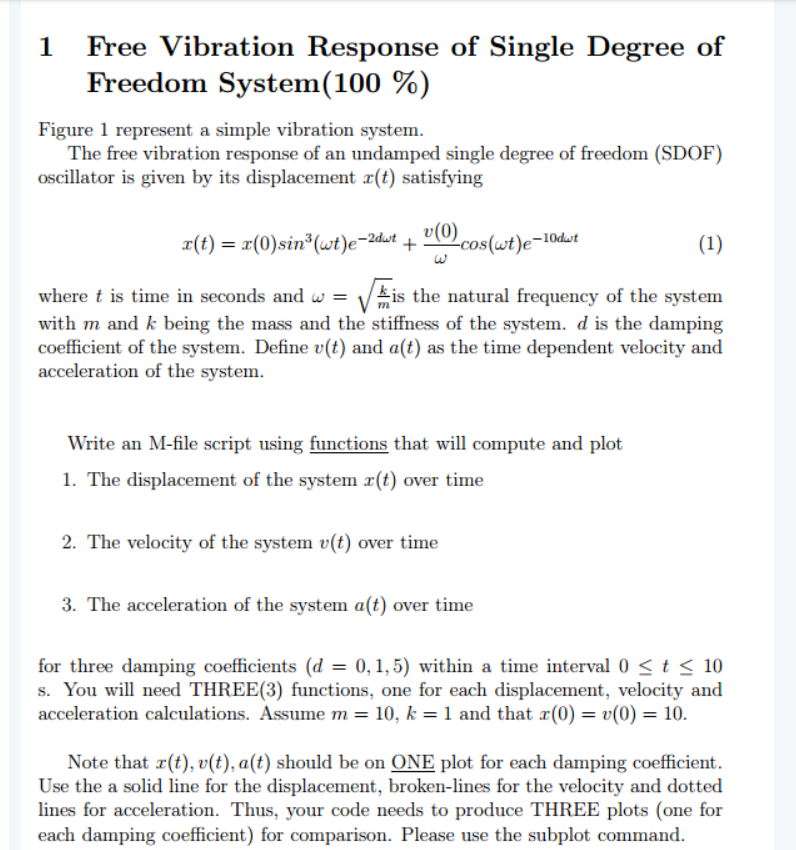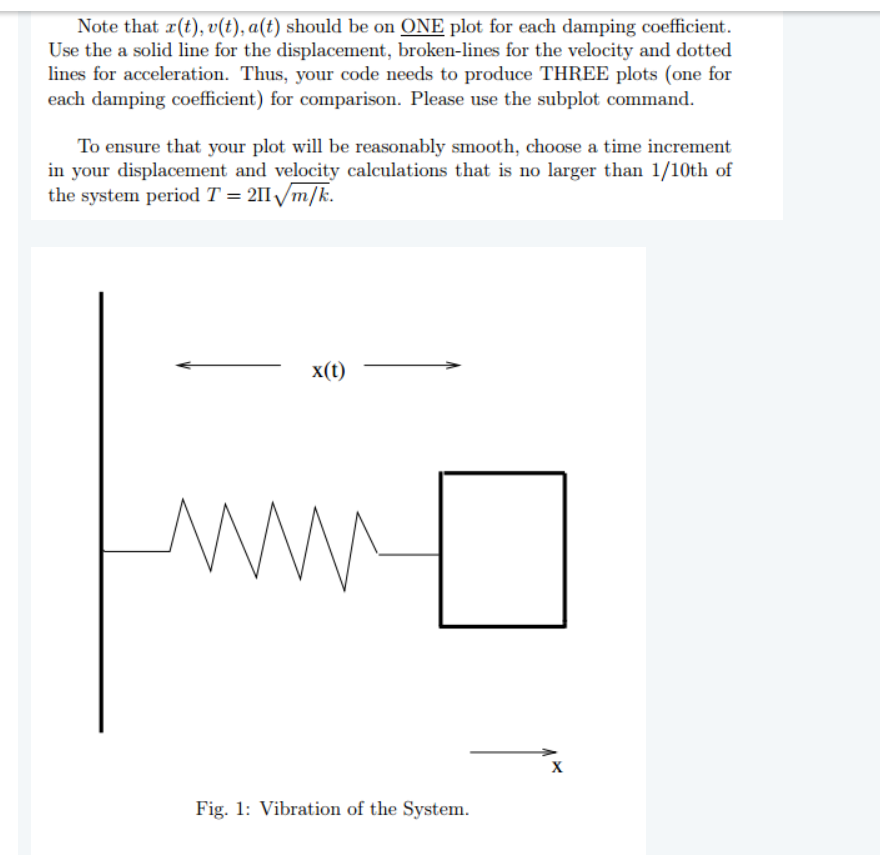1 Free Vibration Response of Single Degree of Freedom System(100 %) 1 Figure 1 represent a simple vibration system. The free vibration response of an undamped single degree of freedom (SDOF) oscillator is given by its displacement x(t) satisfying 1(t) = 1(0)sin*(wt)e-2dut + v(0) 2cos(wt)e-10dwt (1) where t is time in seconds and w = Vis the natural frequency of the system with m and k being the mass and the stiffness of the system. d is the damping coefficient of the system. Define v(t) and a(t) as the time dependent velocity and acceleration of the system. Write an M-file script using functions that will compute and plot 1. The displacement of the system r(t) over time 2. The velocity of the system v(t) over time 3. The acceleration of the system a(t) over time for three damping coefficients (d = 0,1,5) within a time interval 0 < t < 10 s. You will need THREE(3) functions, one for each displacement, velocity and acceleration calculations. Assume m = 10, k = 1 and that x(0) = v(0) = 10. Note that r(t), v(t), a(t) should be on ONE plot for each damping coefficient. Use the a solid line for the displacement, broken-lines for the velocity and dotted lines for acceleration. Thus, your code needs to produce THREE plots (one for each damping coefficient) for comparison. Please use the subplot command.
1 Free Vibration Response of Single Degree of Freedom System(100 %) 1 Figure 1 represent a simple vibration system. The free vibration response of an undamped single degree of freedom (SDOF) oscillator is given by its displacement x(t) satisfying 1(t) = 1(0)sin*(wt)e-2dut + v(0) 2cos(wt)e-10dwt (1) where t is time in seconds and w = Vis the natural frequency of the system with m and k being the mass and the stiffness of the system. d is the damping coefficient of the system. Define v(t) and a(t) as the time dependent velocity and acceleration of the system. Write an M-file script using functions that will compute and plot 1. The displacement of the system r(t) over time 2. The velocity of the system v(t) over time 3. The acceleration of the system a(t) over time for three damping coefficients (d = 0,1,5) within a time interval 0 < t < 10 s. You will need THREE(3) functions, one for each displacement, velocity and acceleration calculations. Assume m = 10, k = 1 and that x(0) = v(0) = 10. Note that r(t), v(t), a(t) should be on ONE plot for each damping coefficient. Use the a solid line for the displacement, broken-lines for the velocity and dotted lines for acceleration. Thus, your code needs to produce THREE plots (one for each damping coefficient) for comparison. Please use the subplot command.
Elements Of Electromagnetics
7th Edition
ISBN:9780190698614
Author:Sadiku, Matthew N. O.
Publisher:Sadiku, Matthew N. O.
ChapterMA: Math Assessment
Section: Chapter Questions
Problem 1.1MA
Related questions
Question

Transcribed Image Text:1
Free Vibration Response of Single Degree of
Freedom System(100 %)
Figure 1 represent a simple vibration system.
The free vibration response of an undamped single degree of freedom (SDOF)
oscillator is given by its displacement x(t) satisfying
x(t) = x(0)sin*(wt)e-2dwt + v(0)
(1)
-cos(wt)e-10dwt
%3D
where t is time in seconds and w = Vis the natural frequency of the system
with m and k being the mass and the stiffness of the system. d is the damping
coefficient of the system. Define v(t) and a(t) as the time dependent velocity and
acceleration of the system.
Write an M-file script using functions that will compute and plot
1. The displacement of the system x(t) over time
2. The velocity of the system v(t) over time
3. The acceleration of the system a(t) over time
for three damping coefficients (d = 0,1,5) within a time interval 0 < t < 10
s. You will need THREE(3) functions, one for each displacement, velocity and
acceleration calculations. Assume m = 10, k = 1 and that r(0) = v(0) = 10.
Note that x(t), v(t), a(t) should be on ONE plot for each damping coefficient.
Use the a solid line for the displacement, broken-lines for the velocity and dotted
lines for acceleration. Thus, your code needs to produce THREE plots (one for
each damping coefficient) for comparison. Please use the subplot command.

Transcribed Image Text:Note that x(t), v(t), a(t) should be on ONE plot for each damping coefficient.
Use the a solid line for the displacement, broken-lines for the velocity and dotted
lines for acceleration. Thus, your code needs to produce THREE plots (one for
each damping coefficient) for comparison. Please use the subplot command.
To ensure that your plot will be reasonably smooth, choose a time increment
in your displacement and velocity calculations that is no larger than 1/10th of
the system period T = 21I /m/k.
x(t)
Fig. 1: Vibration of the System.
Expert Solution
This question has been solved!
Explore an expertly crafted, step-by-step solution for a thorough understanding of key concepts.
This is a popular solution!
Trending now
This is a popular solution!
Step by step
Solved in 5 steps with 4 images

Knowledge Booster
Learn more about
Need a deep-dive on the concept behind this application? Look no further. Learn more about this topic, mechanical-engineering and related others by exploring similar questions and additional content below.Recommended textbooks for you

Elements Of Electromagnetics
Mechanical Engineering
ISBN:
9780190698614
Author:
Sadiku, Matthew N. O.
Publisher:
Oxford University Press

Mechanics of Materials (10th Edition)
Mechanical Engineering
ISBN:
9780134319650
Author:
Russell C. Hibbeler
Publisher:
PEARSON

Thermodynamics: An Engineering Approach
Mechanical Engineering
ISBN:
9781259822674
Author:
Yunus A. Cengel Dr., Michael A. Boles
Publisher:
McGraw-Hill Education

Elements Of Electromagnetics
Mechanical Engineering
ISBN:
9780190698614
Author:
Sadiku, Matthew N. O.
Publisher:
Oxford University Press

Mechanics of Materials (10th Edition)
Mechanical Engineering
ISBN:
9780134319650
Author:
Russell C. Hibbeler
Publisher:
PEARSON

Thermodynamics: An Engineering Approach
Mechanical Engineering
ISBN:
9781259822674
Author:
Yunus A. Cengel Dr., Michael A. Boles
Publisher:
McGraw-Hill Education

Control Systems Engineering
Mechanical Engineering
ISBN:
9781118170519
Author:
Norman S. Nise
Publisher:
WILEY

Mechanics of Materials (MindTap Course List)
Mechanical Engineering
ISBN:
9781337093347
Author:
Barry J. Goodno, James M. Gere
Publisher:
Cengage Learning

Engineering Mechanics: Statics
Mechanical Engineering
ISBN:
9781118807330
Author:
James L. Meriam, L. G. Kraige, J. N. Bolton
Publisher:
WILEY